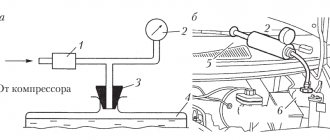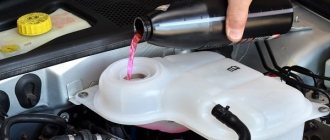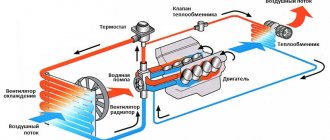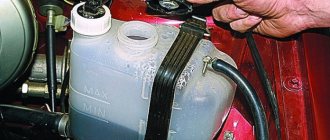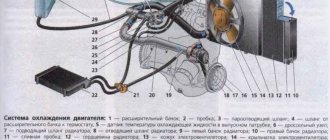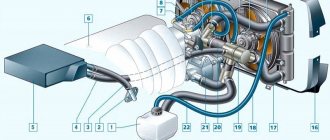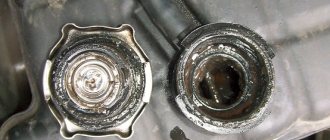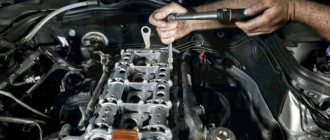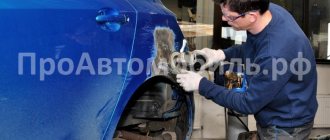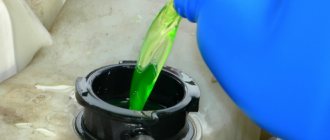Ways to solve the problem
In order not to experience discomfort from the cold inside the car in winter, it is necessary to properly maintain the cleanliness of the cooling system. This will require a lot of effort from the car enthusiast. The main problem in servicing this system is that there is no universal means for cleaning the cooling system from both decomposition products of old antifreeze and corrosion products.
Here we can clearly see two sides of the same coin: acid solutions can easily deal with corrosion products, but they are useless for antifreeze residues (alkali is needed here). As you know from a school chemistry course, combining such products in one composition reduces their effectiveness to zero, because alkali neutralizes acid. As a result of this, we get a completely ineffective remedy.
We can draw a simple conclusion: most commercially available specialized chemicals for cleaning a car’s cooling system will not cope with this task fully, so it is necessary to service it in a timely manner so that you do not have to deal with additional difficulties.
Available means
To flush the cooling system, industry today produces a number of chemical reagents. However, we all know that improvised means can often be much more effective. A separate advantage would be to note the cost-effectiveness of such maintenance methods. One of the main ways to prevent incorrect operation of the “stove” is to flush the engine cooling system with citric acid. Let's see why this method is so popular and how to use this affordable troubleshooter?
What can I use to wash it with?
There is now a wide range of cleaning products available. The most accessible of these is water. However, it is also the least suitable remedy. Due to the salts present in the water in a dissolved state, scale may form after washing, which in the future will cause contamination and repeated cleaning. For this reason, you should use only distilled or, as a last resort, boiled water.
Special cleaning fluids
The range of cleaning liquids of various compositions and concentrations is quite extensive. Most of them allow you to efficiently clean the engine cooling system. But the choice of product should also be taken seriously, since different types of dirt require substances of different compositions to remove.
Cleaning products can be divided into 4 categories:
- Neutral - do not contain aggressive components, are less effective in cleaning the cooling system than other liquids, and are most often used for preventive purposes.
- Acidic - almost never found in pure form due to their extreme aggressiveness to system parts. Acidic flushing fluids are well suited for neutralizing scale and inorganic deposits.
- Alkaline - like the previous category of substances, are not found in an undiluted state. Effectively removes organic contaminants.
- Two-component - contain both acid and alkali. They are consistently poured into the system and thoroughly clean it of all types of contamination.
Coolant racks
It is better not to use two different products at the same time, since the acid and alkali are neutralized during interaction, which may not only not bring the expected result, but also cause a malfunction. You should also not use substances with high concentrations of acids or alkalis, as they can damage rubber and plastic parts.
We recommend: How to quickly remove saffron milk caps from a car body at home
Lemon acid
One of the popular “improvised” cleaning agents is a solution of citric acid. If the correct proportions are observed, it copes well with scale inside the radiator and does not damage rubber components. The optimal ratio is 100 g of acid per 1 liter of water.
Citric acid can be replaced with whey. It contains a concentration of lactic acid sufficient for effective and gentle cleaning. Also, flushing with serum is more gentle on non-metallic parts of the radiator.
As is the case with compositions specifically designed for cleaning, it is better to carry out the process itself in several short steps - this will help to avoid breaking off large pieces of scale.
Cleaning OS with serum
"Coca-Cola" and the consequences of such washing
Another common cleaning product. The orthophosphoric acid contained in the drink effectively removes scale from internal parts. However, this product should be used with caution, because in addition to the aforementioned acid, Coca-Cola also contains sugar, which can clog the system. Therefore, after using Coca-Cola, it is necessary to clean the system again with water to remove any remaining sugar. The concentration of phosphoric acid has a negative effect on rubber and parts.
Another disadvantage of Coca-Cola as a cleaning liquid is its gas content. Gas expansion due to heating during engine operation can lead to negative consequences for the vehicle. Therefore, if you nevertheless decide to use Coca-Cola as a cleaning liquid or do not have the opportunity to use more suitable substances, you need to get rid of the gas it contains.
Coca-Cola for flushing the cooling system
Keeping the engine cooling system clean is one of the important factors in the health of the car. For this purpose, a wide range of specialized cleaning liquids are available, which, if chosen correctly, will help maintain the optimal condition of this system, as well as all sorts of available alternatives. But when using the latter, you should be careful and resort to them in the absence of more suitable substances.
How to flush the engine cooling system with citric acid
The process seems complicated. However, we hasten to assure you that there is nothing critically difficult about it. It is enough to go through several stages of preparation:
- calculate the required mass of citric acid;
- prepare a working solution;
- prepare a container for draining antifreeze, rags and available materials in case you spill anything.
We will start by calculating the required volume. The most important component of the preparation when flushing the engine cooling system with citric acid is the proportion of the active substance. For a volume of 8 liters, about 150 grams of citric acid is needed. Standard sachets are usually available in 30 gram packs (we will need at least 5 sachets. More is better).
We recommend purchasing citric acid in advance, with a small supply.
Flushing with home remedies
Preventative work to remove scale and dirt is carried out every 6-12 months. In Soviet times, technical channels were regularly cleaned with “acidified” water. Baking soda, citric acid and vinegar were used. The solution was made in small concentrations so that the inner walls would not oxidize in an aggressive environment. The work was carried out carefully, taking into account the contamination of the canals. Such methods remain relevant today, and the process demonstrates the desired effect.
If you do not flush the cooling system, you may encounter unpleasant problems:
- breakdown of the distillate heater;
- unstable operation of the heating stove;
- water pump blockage.
To avoid disastrous consequences, you need to figure out how to flush the car’s cooling system. Modern cleaning methods at large service stations are based on the use of special expensive compounds. Their range of use is designed to remove all possible contaminants and allows you to get rid of organic deposits and rust.
We recommend: When should you change the fuel filter on a Renault Logan?
Additives are produced on the basis of two-component compositions. There are neutral options consisting of an acidic or alkaline solution. Additives provide a targeted action to eliminate a specific type of contamination.
Rinsing with distilled water
After draining the old coolant, the system is filled with distilled water.
Necessary:
- close the valves on the radiator and cylinder block;
- start the car;
- keep the engine idling for up to 20 minutes;
- wait for cooling and repeat the procedure.
Washing is considered complete when the distillate at the outlet is cleared of foreign inclusions. This method allows you to wash out accumulated dirt, but will not clear the channels and internal surfaces of deposits.
How to flush the engine cooling system with citric acid
It is necessary to prepare a concentrated solution. The calculation is made in the optimal proportion - 200 grams of citric acid per 10 liters of boiled water. The composition is poured into the expansion tank until the system is completely filled, but not above the maximum level.
For the solution to warm up and react, you need to drive several kilometers.
The coolant temperature is monitored by a sensor. The scale decomposition reaction is effective at a temperature of 80 degrees. After the engine has cooled, repeat the process with a lower concentration of solution (100 g per 10 liters of water). The next flushing is carried out with clean water, and then antifreeze or antifreeze is added.
Washing with acetic acid
The procedure is also effective with 9% table vinegar. A 0.5 liter bottle is dissolved in a bucket of boiled water. The procedure consists of the following steps:
- warm up the engine for about 30 minutes;
- leave the charged system for at least 8 hours or overnight;
- drain the used liquid and rinse with distillate.
When adding antifreeze, bleed any air bubbles from the cooling system.
Whey wash
The option with lactic acid or whey is an effective way to clean OS. The car will need to run in active mode (at medium engine speeds) for about half an hour or drive 40-50 km without stopping.
Homemade serum is more effective than store-bought serum. You will need to strain it several times through a thick layer of gauze. It is possible to filter through a sieve, but with a fine mesh.
The serum is poured into the radiator in its pure form, without dilution with water. After washing, add water and drive again for 5-10 km. This is necessary to remove baked milk products in the technological channels. After making sure that the OS has been cleaned, fill in with clean distillate.
Washing with soda solution
Cleaning with soda is a thorough and special procedure. A careless approach can lead to excessive oxidation of metal and rubber parts. The procedure is used once a year or after traveling 50-60 thousand km. Particular attention is paid to the ratio of the components of the combined solution:
- 3%!caustic soda;
- 7-10%! soda ash;
- 85-90%! boiled or distilled water.
After filling the system, you will need to drive the car up to 100 km, but you should not leave the soda solution in the radiator for more than 1 day.
For 10 liters of water use no more than 1 kg of baking soda.
We recommend: Lubricating compounds for guides and calipers - which lubricants are better and why
If you use a sodium bicarbonate solution, you will need to thoroughly flush the system several times. After making sure that dirt and salt deposits have been completely cleaned, fill in a new distillate.
Flushing with Coca-Cola
The folk method involves using the carbonated drink Coca-Cola. This is an effective method with its own nuances. The drink contains orthophosphoric acid, which reacts with the polymer parts of the internal combustion engine CO. The disadvantage of the method is the high sugar content in Cola, which, when overheated, is deposited on the inner walls of the metal elements of the pipeline.
Features of the method:
- Before use, release all carbon dioxide from the soda;
- fluid circulation in a running engine - no more than 15 minutes at a temperature of less than 100 degrees.
Despite the good quality of cleaning, you should not often resort to this option. With frequent use, a negative effect of “Cola” on rubber pipes has been revealed.
Procedure
First of all, you need to drain the antifreeze. To avoid wasting this valuable substance, we strongly recommend that you drain it carefully. To do this, you can use any convenient container: a bucket, an empty plastic bottle, etc. After removing the protective shield, unscrew the cap on the radiator, first replacing the container. Antifreeze can drain quite slowly, so be patient. To adjust the intensity, you can use the plug closing the expansion tank.
Then you can start working directly with our “magic” solution. After pouring diluted citric acid into the cooling system, add a little water according to the level. The following is what needs to be done:
- start the car, warm up the engine a little (to about 50 degrees);
- in neutral gear, increase the gas (up to approximately 3 thousand revolutions), let the engine run in this mode for some time (8-10 minutes is enough to warm up to 100 degrees);
During such warming up, a good “running” of the cooling system is ensured. After 10 minutes, turn off the engine and let it sit for a while. After a break, starting the car again, a sharp increase in engine temperature will be noticeable. This indicates that the liquid in the cooling system is no longer circulating. You should immediately turn off the engine and then carefully remove the throttle body hose. This will ensure free flow of gas.
Further interaction with the machine will be cyclical: warming up and removing the hose. After about an hour, you can safely drain the liquid (rinsing solution with citric acid), while rinsing the cooling system several times with plain water. 4-5 washes are enough to achieve a good result (the dark color of the water should completely disappear).
How to flush the cooling system when changing the fluid?
If the check reveals that the coolant has an uncharacteristic color, or the engine begins to overheat in hot weather, then it is necessary to drain the old coolant and flush the system with water. You can find the volume of the machine's cooling system in the owner's manual or on the Internet. Usually this is about 7-8 liters for common engines with a volume of 1.5 - 1.6.
Flushing the system with water is simple: fill in the required flush volume, start the engine and wait for the thermostat to open. Let the engine idle for 10 minutes. After this, turn off and let cool. Then the water must be drained and, if possible, the system must be purged with a compressor. If the water is dirty, repeat the procedure.
At the end of the flushing, coolant is added. Every 100 kilometers you need to check its level, the absence of leaks at the joints of the system, and observe the color of the liquid. If it changes again, the system needs more serious flushing.
Advantages and disadvantages of the washing method
Of course, “folk” methods of repair and maintenance have both their supporters and opponents. Professional products for flushing the cooling system contain stronger acids, which naturally will have a positive effect on the quality of maintenance. But this is not always the case. A simple method of preparing a washing solution (such as diluting citric acid) significantly saves the car owner’s money, and the result may suffer minimally (or not at all). The choice is yours. It all depends solely on your desire and trust in the manufacturers of chemicals for car maintenance, as well as on the ability to incur regular expenses for expensive consumables.
Problem prevention
After completing the flushing, we recommend carefully monitoring the condition of the engine (in particular, the temperature). If noticeable heating occurs, it is necessary to immediately stop the vehicle, turn off the engine and carry out maintenance on the cooling system. Sudden temperature changes in most cases are due to the fact that the liquid inside the system does not circulate.
In extreme situations, contact a car service center for a comprehensive inspection and diagnosis of cooling system problems. Driving a car with high engine heating rates is extremely dangerous. It can lead to serious problems and the need for major repairs. Good luck on the roads!
